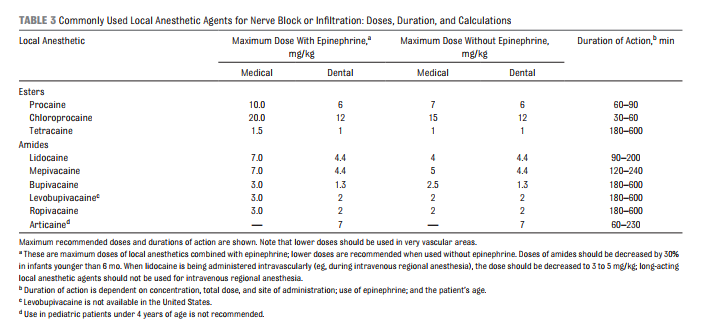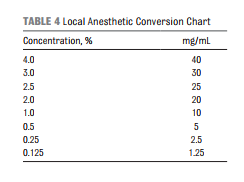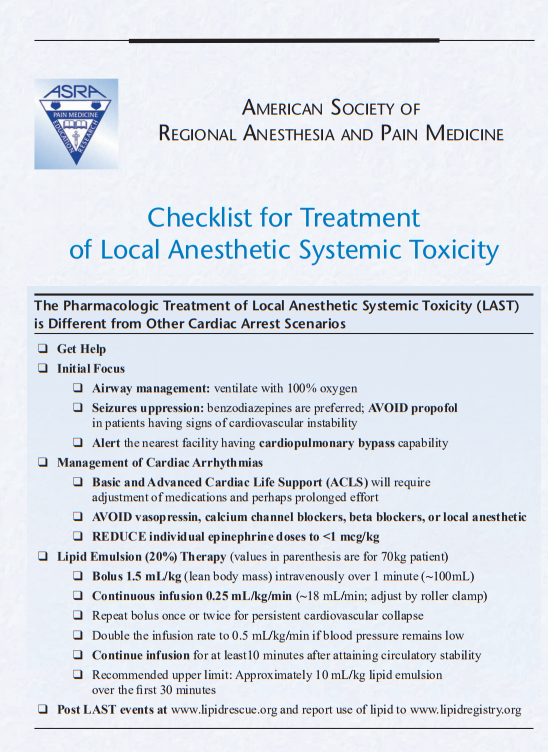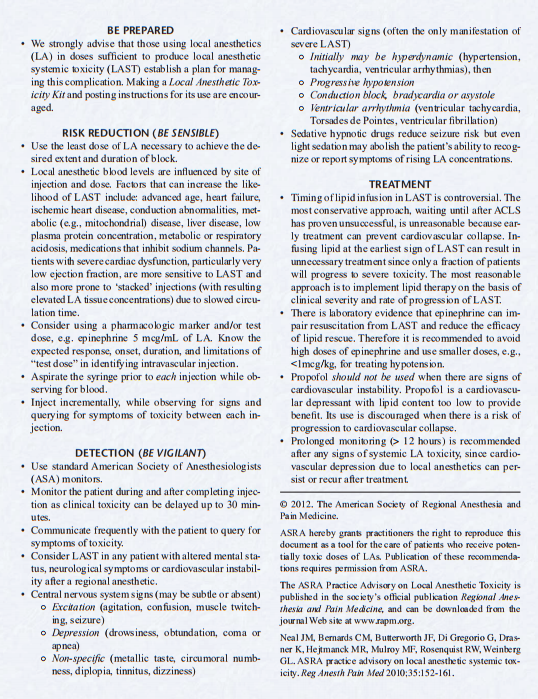This post covers local anesthetic agents [Resources (1) and (2)] and the management of local anesthetic systemic toxicity [Resource (3)]. In addition, I’ve included links to two posts on local anesthetic systemic toxicity from prominent emergency medicine specialists [Resources (4) and (5)].
The following are excerpts from Resource (1):
Local Anesthetic Agents
All local anesthetic agents are cardiac depressants and may cause central nervous system excitation or depression. Particular weight-based attention should be paid to cumulative dosage in all children.118, 120, 125, 383–386 To ensure that the patient will not receive an excessive dose, the maximum allowable safe dosage (eg, mg/kg) should be calculated before administration. There may be enhanced sedative effects when the highest recommended doses of local anesthetic drugs are used in combination with other sedatives or opioids (see Tables 3 and 4 for limits and conversion tables of commonly used local anesthetics).118, 125, 387–400 In general, when administering local anesthetic drugs, the practitioner should aspirate frequently to minimize the likelihood that the needle is in a blood vessel; lower doses should be used when injecting into vascular tissues.401 If high doses or injection of amide local anesthetics (bupivacaine and ropivacaine) into vascular tissues is anticipated, then the immediate availability of a 20% lipid emulsion for the treatment of local anesthetic toxicity is recommended (Tables 3 and 5).402–409 Topical local anesthetics are commonly used and encouraged, but the practitioner should avoid applying excessive doses to mucosal surfaces where systemic uptake and possible toxicity (seizures, methemoglobinemia) could result and to remain within the manufacturer’s recommendations regarding allowable surface area application.410–415
Local Anesthetic Systemic Toxicity recognition and treatment is reviewed in Resource (3) below from The American Society Of Regional Anesthesia And Pain Medicine:
Resources:
(1) Guidelines for Monitoring and Management of Pediatric Patients Before, During, and After Sedation for Diagnostic and Therapeutic Procedures: Update 2016 [PubMed Abstract] [Full Text HTML] [Full Text PDF]. Pediatrics. 2016 Jul;138(1). pii: e20161212. doi: 10.1542/peds.2016-1212.
(2) Supplemental Information for Resource (1) above. [PDF]
- APPENDIX 1: RECOMMENDED DISCHARGE CRITERIA
- APPENDIX 2: ASA PHYSICAL STATUS CLASSIFICATION*
- APPENDIX 3: DRUGS† THAT MAYBE NEEDED TO RESCUE A SEDATED
PATIENT - APPENDIX 4: EMERGENCY EQUIPMENT THAT MAY BE NEEDED
(3) Checklist for Treatment of Local Anesthetic Systemic Toxicity from the AMERICAN SOCIETY OF REGIONAL ANESTHESIA AND PAIN MEDICINE
(4) Dr. Morganstern’s post Local anesthetic toxicity April 4, 2015 from First10EM.
(5) Dr. Swaminatham’s post Local Anesthetic Systemic Toxicity from R.E.B.E.L.EM.









